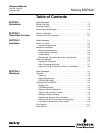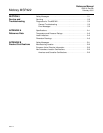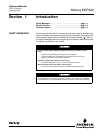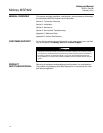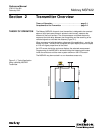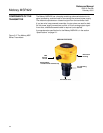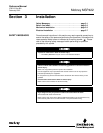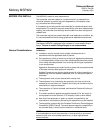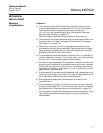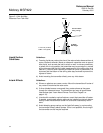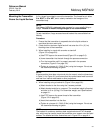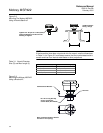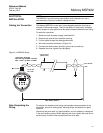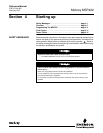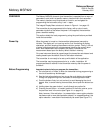
Reference Manual
IP2013, Rev BA
February 2012
3-3
Mobrey MSP422
MECHANICAL
INSTALLATION
Mounting
Considerations
Guidelines:
a) The transmitter should be mounted above the liquid surface using the
2-inch thread provided, but not closer than 12 in. (0,3 m) to the surface.
The transmitter does not detect any liquid surface closer than
12 in. (0,3 m) to the transmitter face. (See "Mounting the Transmitter
Above the Liquid Surface" on page 3-5).
Optional flanges and bracket kits are available to help mounting.
b) The transmitter should be mounted vertically to ensure a good echo from
the liquid surface. The beam half angle of the transmitter is 6 degrees.
(See Figure 3-1 on page 3-4).
c) Obstructions in the tank, or well, may generate echoes which can be
confused with the real liquid surface echo. Obstructions within the beam
angle generate strong false echoes. Wherever possible, the transmitter
should be positioned to avoid false echoes.
d) To avoid detecting unwanted objects in the tank or well, it is advisable to
maintain a distance of at least 1.3 in. from the center line of the transmitter
for every foot (11 cm per meter) range to the obstruction.
e) No false echoes are generated if the transmitter is located near the side of
the tank or well, and the wall is smooth and free of protrusions. However,
there will still be a reduction in the echo size. It is recommended that the
transmitter be mounted no closer than 12 in. (0,3 m) to the wall to avoid a
large reduction in the echo size.
f) If the transmitter is mounted in an enclosed tank with a domed top, avoid
mounting the transmitter in the center of the tank roof because this could
act as a parabolic reflector and create unwanted echoes.
g) Avoid applications where heavy condensation could form on the
transmitter face.
h) If the transmitter is mounted in a stand-off or nozzle, the transmitter face
should protrude at least 0.2 in. (5 mm) into the tank. If this is not possible,
see "Mounting the Transmitter Above the Liquid Surface" on page 3-5).
i) If the transmitter is used in environments where direct sunlight can cause
high surface temperatures on exposed instruments, a sun-shade is
recommended.



